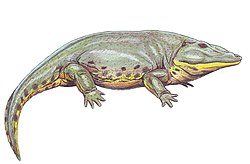| Archegosauroids Temporal range: Pennsylvanian to Late Permian, | |
|---|---|
 | |
| Prionosuchus | |
| Scientific classification | |
| Domain: | Eukaryota |
| Kingdom: | Animalia |
| Phylum: | Chordata |
| Order: | † Temnospondyli |
| Clade: | † Stereospondylomorpha |
| Superfamily: | † Archegosauroidea Lydekker, 1885 |
| Families | |
Archegosauroidea is an extinct superfamily of Permian temnospondyls. The superfamily is assigned to the clade Stereospondylomorpha and is the sister taxon to the suborder Stereospondyli. [1] It includes the families Actinodontidae and Archegosauridae, and possibly the genus Intasuchus , which is placed within the monotypic family Intasuchidae. They were fully aquatic animals, and were metabolically and physiologically more similar to fish than modern amphibians. [2]








